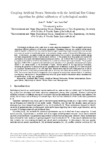Mostrar o rexistro simple do ítem
Coupling artificial neural networks with the artificial bee colony algorithm for global calibration of hydrological models
| dc.contributor.author | Cea, Luis | |
| dc.contributor.author | Farfán-Durán, Juan F. | |
| dc.contributor.other | Enxeñaría da Auga e do Medio Ambiente (GEAMA) | es_ES |
| dc.date.accessioned | 2024-02-15T14:56:09Z | |
| dc.date.available | 2024-02-15T14:56:09Z | |
| dc.date.issued | 2021 | |
| dc.identifier.citation | Farfán, J. F., & Cea, L. (2021). Coupling artificial neural networks with the artificial bee colony algorithm for global calibration of hydrological models. Neural Computing and Applications, 33, 8479-8494. https://doi.org/10.1007/s00521-020-05601-3 | es_ES |
| dc.identifier.uri | http://hdl.handle.net/2183/35622 | |
| dc.description | Versión aceptada de https://doi.org/10.1007/s00521-020-05601-3 | es_ES |
| dc.description.abstract | [Abstract:] Hydrological models are widely used tools in water resources management. Their successful application requires an efficient calibration of the model parameters. Nowadays, there are very powerful global search methods applied to this end, but they have the disadvantage of presenting a high computational cost, because the numerical model to be calibrated needs to be evaluated a large number of times with different parameter sets. In this context, surrogate models can reduce significantly the run time of hydrological models, easing the total computational burden of global search methods. In the present work, we propose and explore the combination of a swarm intelligence-based optimization method, the artificial bee colony algorithm, with a surrogate model based on artificial neural networks in order to calibrate hydrological models. The proposed approach (ABC-ANN) is applied to the calibration and validation of a nine-parameter continuous hydrological model in two basins located in the northwest of Spain. Several aspects of the algorithm are evaluated, including its capability to calibrate the model parameters and its efficiency in terms of CPU time compared to a standard implementation of the ABC algorithm. Results show that the ABC-ANN algorithm is able to identify the location of suitable parameter sets with an accuracy rate within 89 and 99 %, and a reduction in CPU time of more than three orders of magnitude when compared to a sequential implementation. In addition, the frequency distribution of the parameter sets identified gives valuable information about the sensitivity of model output to the input parameters. | es_ES |
| dc.description.sponsorship | This study is financed by the Galician government (Xunta de Galicia) as part of its pre-doctoral fellowship program (Axudas de apoio á etapa predoutoral 2019) Register No ED481A-2019/014. | es_ES |
| dc.description.sponsorship | Xunta de Galicia; ED481A-2019/014 | es_ES |
| dc.language.iso | eng | es_ES |
| dc.publisher | Springer | es_ES |
| dc.relation.uri | https://doi.org/10.1007/s00521-020-05601-3 | es_ES |
| dc.rights | © The Author(s), under exclusive licence to Springer-Verlag London Ltd. part of Springer Nature 2021 | es_ES |
| dc.subject | Artificial bee colony | es_ES |
| dc.subject | Artificial neural networks | es_ES |
| dc.subject | Global optimization | es_ES |
| dc.subject | Surrogate model | es_ES |
| dc.subject | Hydrological model | es_ES |
| dc.subject | Water resources management | es_ES |
| dc.title | Coupling artificial neural networks with the artificial bee colony algorithm for global calibration of hydrological models | es_ES |
| dc.type | info:eu-repo/semantics/article | es_ES |
| dc.rights.access | info:eu-repo/semantics/openAccess | es_ES |
| UDC.journalTitle | Neural Computing and Applications | es_ES |
| UDC.volume | 33 | es_ES |
| UDC.startPage | 8479 | es_ES |
| UDC.endPage | 8494 | es_ES |
| dc.identifier.doi | 10.1007/s00521-020-05601-3 |






